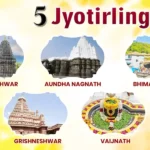Overview
One of India’s most spiritually important states is Maharashtra, the land of saints, temples, and colorful customs.
Every year, millions of tourists and devotees are drawn to the state’s cultural legacy, which includes stunning temples and old caves.
Selecting a reputable travel agency in Maharashtra can greatly improve the experience for people who want to easily explore the spiritual richness.
The Ashtavinayak Yatra is one of the state’s most revered spiritual circuits. This pilgrimage, which is dedicated to Lord Ganesha, the remover of obstacles, entails touring eight revered temples, all of which are rich in myth and history.
Lord Ganesha’s significance in Maharashtra
In Maharashtra, Lord Ganesha, affectionately known as Ganpati, is highly esteemed. His name reverberates in every house, temple, and street, particularly on holidays like Ganesh Chaturthi.
Ganpati represents knowledge, wealth, and the dismantling of barriers. It is believed that going on the Ashtavinayak Yatra is a means of asking for his blessings for a prosperous and trouble-free life.
The Ashtavinayak Yatra: What is it?
Eight historic temples in and around Pune that are devoted to Lord Ganesha are included in the Ashtavinayak Yatra, a pilgrimage. Every temple has a distinct narrative and historical significance. The Moreshwar Temple in Morgaon is where pilgrims customarily begin and finish the Yatra.
An overview of the temples of Ashtavinayak
The temples on the Ashtavinayak Ganpati circuit are as follows:
Temple of Moreshwar (Morgaon)
Temple of Siddhivinayak (Siddhatek)
Temple of Ballaleshwar (Pali)
Mahad’s Varadvinayak Temple
Temple of Chintamani (Theur)
Temple of Girijatmaj (Lenyadri)
Temple of Vighnahar (Ozar)
Rajangaon’s Mahaganapati Temple
All of these temples may be easily visited in two to three days and are all within a few hundred kilometers of Pune.
A Comprehensive Account of Every Temple
1. Morgaon’s Moreshwar Temple is 65 kilometers from Pune.
Specialty: regarded as the Ashtavinayak Yatra’s beginning and finish.
Legend: This is where Ganesha battled the demon Sindhu.
October through February is the ideal time to visit.
2. Siddhatek, or Siddhivinayak Temple
The distance from Pune is 100 kilometers.
Specialty: The only temple with the statue of Ganesha facing right.
Legend: After worshiping Ganesha here, Lord Vishnu vanquished demons.
Winter is the best time to go because of the nice weather.
3. The Ballaleshwar Temple in Pali is 110 kilometers from Pune.
Specialty: The sole Ganesha temple bearing Ballal, a devotee.
Legend: Ballal, a youthful devotee, was blessed by Ganesha.
November through February is the ideal time to visit.
4. Mahad’s Varadvinayak Temple
The distance from Pune is 146 kilometers.
Specialization: Self-originated idol (Swayambhu).
Legend: Rukmangada, a monarch who was loyal to Ganesha, was blessed by him.
The post-monsoon season is the ideal time to visit.
5. Theur’s Chintamani Temple
The distance from Pune is 25 kilometers.
Ganesha’s specialty is relieving followers of their anxieties (Chinta).
Legend: For Sage Kapila, Ganesha retrieved the priceless Chintamani diamond.
The best time to go is all year long, but particularly around festivals.
6. Lenyadri’s Girijatmaj Temple
The distance from Pune is 94 kilometers.
Specialty: Found among a series of caves.
Legend: In order to obtain Ganesha as her son, Goddess Parvati underwent penance here.
November through March is the ideal time to visit.
7. The Temple of Vighnahar (Ozar)
The distance from Pune is 85 kilometers.
Specialty: Linked to obstacle clearance (Vighnas).
Legend: This is where Ganesha vanquished the demon Vighnasur.
December through February is the ideal time to visit.
8. Ranjangaon’s Mahaganapati Temple
The distance from Pune is 50 kilometers.
Specialty: Tripurasura is vanquished by the strong idol of Ganesha.
Legend: Before facing the demon Tripurasura, Shiva worshipped Ganesha here.
Winter is the ideal season to visit.
Also read:- ashtavinayak darshan yatra from pune
How to Choose the Best Route for the Ashtavinayak Yatra
Morgaon → Siddhatek → Pali → Mahad → Theur → Lenyadri → Ozar → Ranjangaon → Return to Morgaon is the traditional order in which the Yatra begins at Moreshwar Temple (Morgaon).
The number of days required
Depending on the starting place and pace, the circuit can be comfortably finished in two to three days.
The Best Time of Year to Go
The temperate, pleasant weather of October through February makes it the ideal time of year to visit Ashtavinayak temples.
The most practical and flexible travel option is a private vehicle.
Public Transportation: Although buses are available, they sometimes take a long time.
Bus Tours: Less flexible but still organized group tours.
Families and groups are advised to choose Maharashtra car rental services to guarantee a flexible and enjoyable trip. Complete Ashtavinayak tour packages that include lodging, transportation, and guided services are available from a number of Maharashtra travel agencies.
Advantages of Selecting a Maharashtra Travel Agency
Working with a reputable Maharashtra travel agency offers:
A well-planned itinerary that visits every temple in the proper, customary order.
Buses, Tempo Travelers, or AC automobiles are all options for comfortable transportation.
Accommodations: Packages include hotel reservations.
Guided Tours: An explanation of each temple’s mythology and history.
Selecting the appropriate travel company guarantees a stress-free, enjoyable trip.
Car Rentals for the Ashtavinayak Yatra
Maharashtra car rental services provide several advantages, including:
Comfort of a Family Vacation: Private vehicles offer room and freedom.
Time-saving: Not reliant on set transport timetables.
Options for Self-Drive or Chauffeur-Driven: Based on your preferences, make your choice.
It’s best to reserve your rental car in advance, particularly during Ganesh Chaturthi and other holiday seasons when a lot of people visit the temples.
Extra Advice for Travelers
Wear lightweight clothing and supportive shoes for comfort.
Start Early: Get your day started early to avoid the crowds.
Observe customs: Keep temple etiquette.
Reservations in Advance: During festival seasons, reserve lodgings in advance.
Bring the necessities: basic medications, snacks, and water bottles.
In conclusion
Beyond only being a religious pilgrimage, the Ashtavinayak Yatra is a profoundly spiritual event that offers blessings, tranquility, and a sense of cultural diversity. Choosing a trustworthytravel agency in Maharashtra and making use of car rental services in Maharashtra may make your pilgrimage easy, comfortable, and genuinely unforgettable, regardless of whether you are going alone, with family, or with friends.
Arrange your holy voyage now and visit Maharashtra’s stunning temples to seek Lord Ganpati’s divine blessings!






